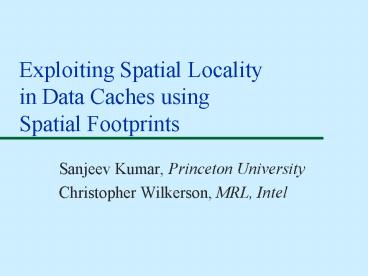Exploiting Spatial Locality in Data Caches using Spatial Footprints PowerPoint PPT Presentation
1 / 24
Title: Exploiting Spatial Locality in Data Caches using Spatial Footprints
1
Exploiting Spatial Locality in Data Caches using
Spatial Footprints
- Sanjeev Kumar, Princeton University
- Christopher Wilkerson, MRL, Intel
2
Spatial Locality in Caches
- Current approach Exploit spatial locality within
a cache line - Small cache line
- Lower bandwidth
- Less pollution
- Big cache line
- Exploit more locality
- Fewer tags
- Current caches use 32 byte lines
Access
Cache Line
3
Spatial Locality in Caches contd.
- Spatial locality exhibited varies
- Across applications
- Within an application
- Using fixed size line to exploit locality
- Inefficient use of cache resources
- Less than half the data fetched is used
- Wastes bandwidth, Pollutes cache
- Limited benefit of spatial locality
4
Outline
- Introduction
- Spatial Footprint Predictors
- Practical Considerations
- Future Work
- Related Work
- Conclusions
5
Spatial Footprint Predictor (SFP)
- Exploit more spatial locality
- Need to reduce pollution
- Fetch words selectively
- Requires accurately predicting spatial footprint
of a block - Bit Vector
- 0100 1011 0010 0010
6
Spatial Footprint Predictor contd.
- Record spatial footprints
- Use footprint history to make predictions
- Lookup table based on
- Nominating data address
- Nominating instruction address
- Combination
- L1 data caches
0100101100100010
7
Simple Approach
- Use large cache lines
- Fetch specific words
- leave holes for words that were not fetched
- Might decrease bandwidth
- Increases miss ratio
- missed lines
- under-utilization of cache
8
Our Approach
- Regular cache with small lines
- 8 bytes i.e. one word
- Exploit spatial locality at sector granularity
- 16 lines i.e. 128 bytes
- Spatial Footprint Predictor
- Fetch 1-16 lines in a sector on a miss
9
When to Record/Predict footprints?
- Sectors in memory are active or inactive
- Active
- Record footprints
- cache miss in an inactive sector
- Inactive
- Use history to predict
- Cache miss on a line that is marked used
(footprint) in an active sector - Use infinite size tables
10
Recording Footprints
SF
NA
SF
1001 ...
1000 ...
0100101100100010
0100 ...
Done
6
0100 ...
Active Sector Table
Spatial Footprint History Table
Cache
(Records FP)
(Stores FP)
11
Predicting Footprints
SF
Fetch Lines
1001 ...
1000 ...
0100101100100010
0100 ...
Predicted Footprint
Access
Spatial Footprint History Table
Cache
12
The default footprint predictor
- When SFP has no prediction
- No history
- Evicted from Spatial Footprint Table
- Picks a single line size for the application
- Based on the footprints observed
13
Experimental Setup
- Cache Parameters
- 16 KB L1
- 4-way associative
- 8 bytes per line
- 16 lines per sector
- Cache simulator
- Miss Ratios
- Fetch bandwidth
- 12 Intel MRL traces
- gcc and go (SPEC)
- Transaction processing
- Web server
- PC applications
- word processors
- spreadsheets
- Normalized results
- 16KB conventional cache with 32 byte line
14
Experimental Evaluation
Normalized Miss Ratios
15
GCC Comparison
16
GCC Comparison Contd.
- Comparing SFP cache to
- Conventional caches with varying line sizes
- Comparable to best miss ratio (using 64 byte
lines) - Close to lowest bandwidth (using 8 byte lines)
- Bigger conventional cache
- Comparable to a 32 KB Cache
17
Outline
- Introduction
- Spatial Footprint Predictors
- Practical Considerations
- Future Work
- Related Work
- Conclusions
18
Decoupled Sectored Cache
- Seznec et. al.
- Proposed to improve sectored L2 cache
- Decouple tag array from data array
- Dynamic mapping no longer one-to-one
- Multiple lines from the same sector share tags
- Flexible Data and tag array can be of different
sizes and associativities
19
Practical Considerations
- Reasonable Spatial Footprint History Table
- 1024 entries
- Reduce Tag Storage
- Use Decoupled Sectored Cache
- Same number of tags as a conventional cache with
32 byte lines - Both data and tag array are 4-way associative
20
Experimental Evaluation
Normalized Miss Ratios
21
Cost
- Additional Space
- 9 KB
- Can be reduced by
- Using partial tags
- Compressing footprints
- Time
- Most predictor actions are off the critical path
- Little impact on cache access latency
22
Future Work
- Improve miss ratios further
- Infinite tables 30
- Practical Implementation 18
- Reduce the additional memory required
- Better coarse grained predictor
- L2 Caches
23
Related Work
- Przybylski et. al., Smith et. al.
- Statically best line size, fetch size
- Gonzalez et. al.
- Dual data cache temporal and spatial locality
- Numeric codes
- Johnson et. al.
- Dynamically pick line size per block (1 KB)
24
Conclusions
- Spatial Footprint Predictors
- Decrease miss ratio (18 on average)
- Reduce bandwidth usage
- Little impact on cache access latency
- Can use fine-grain predictor for data caches

